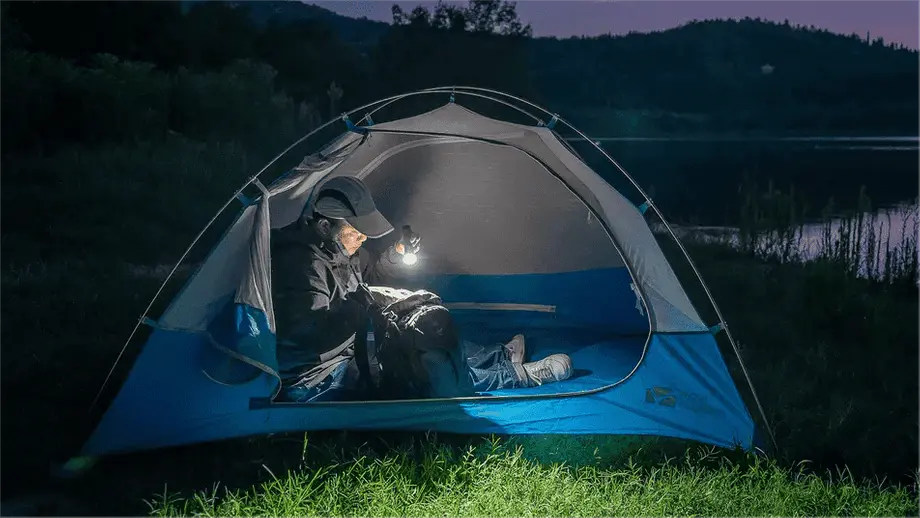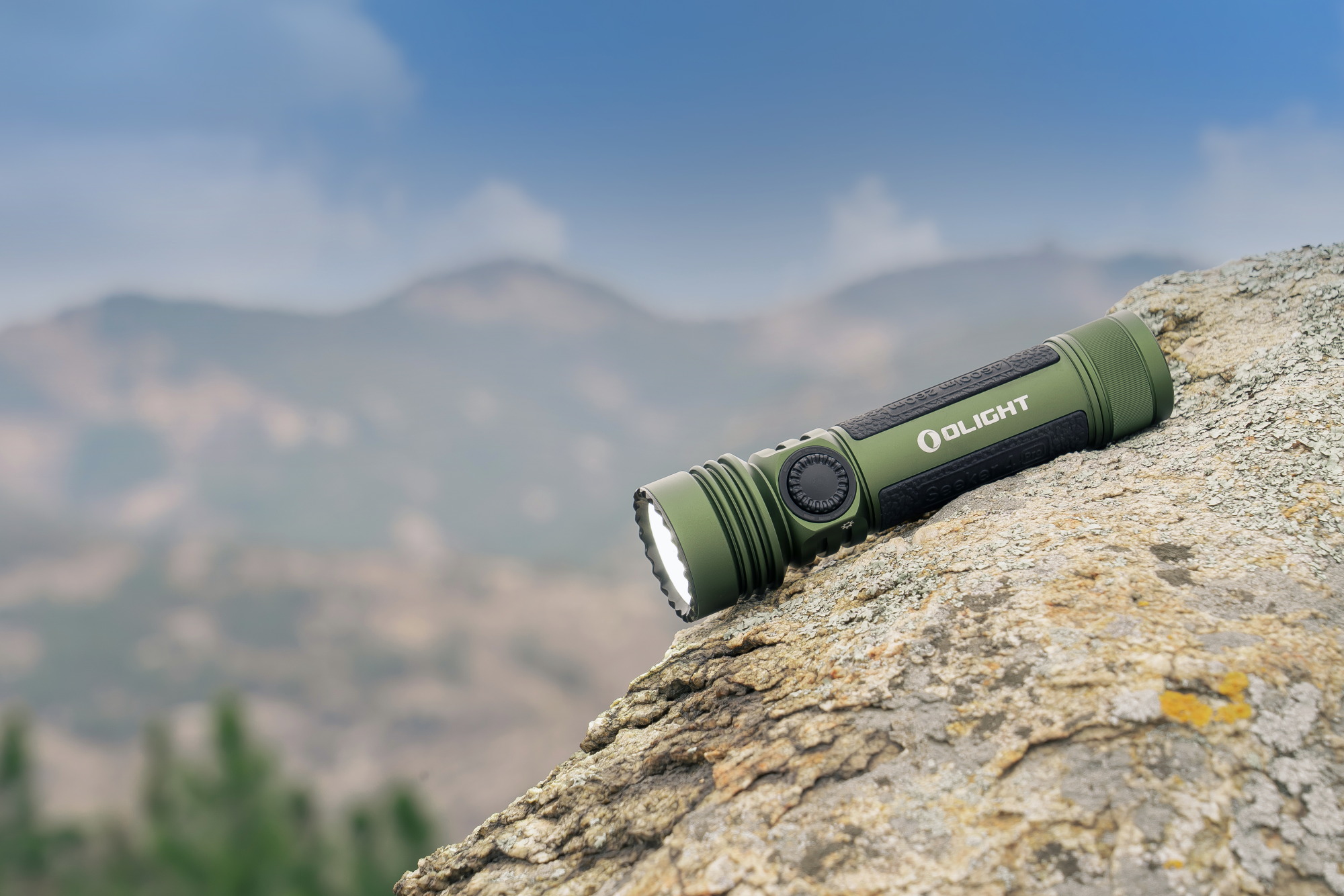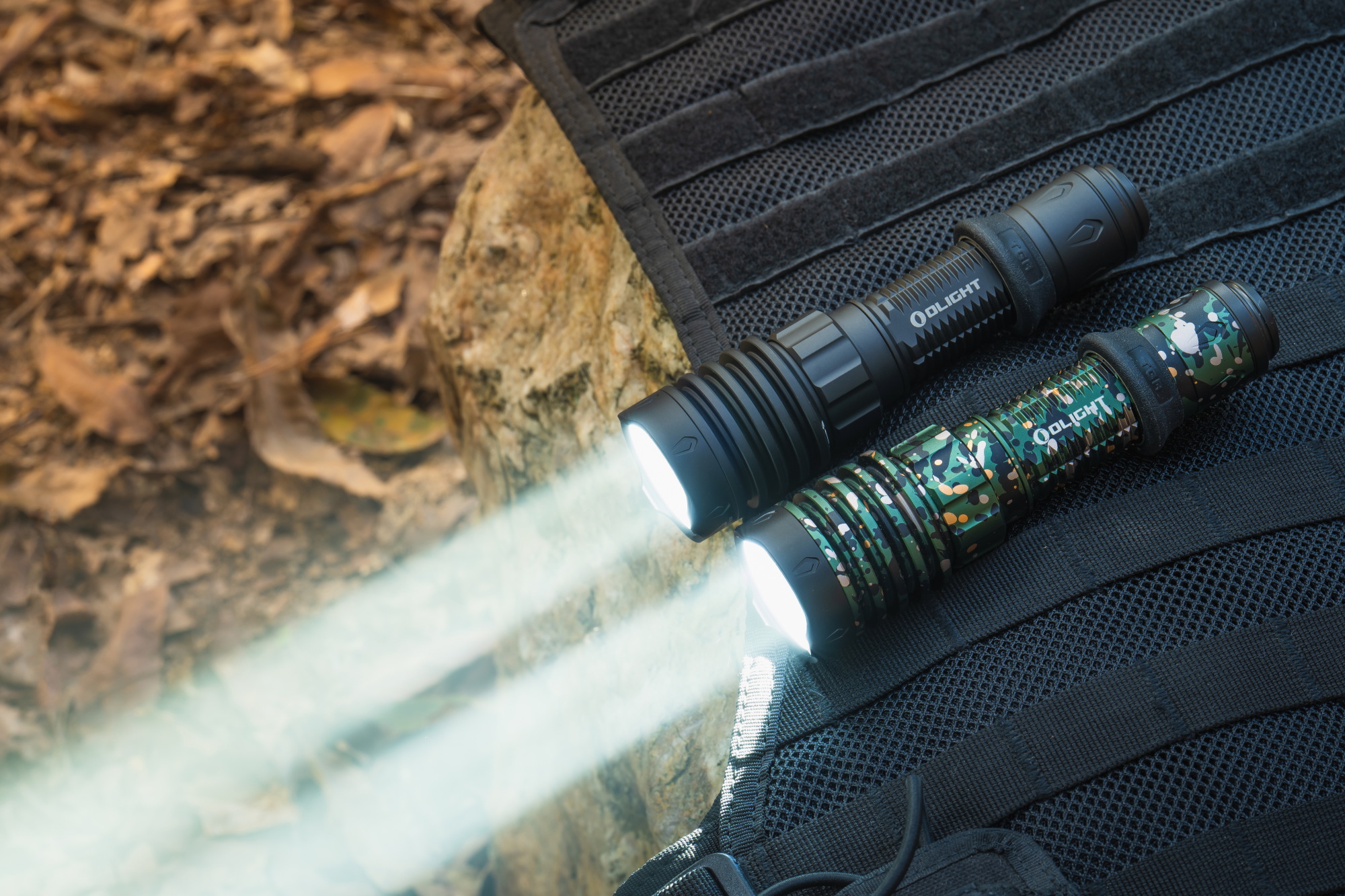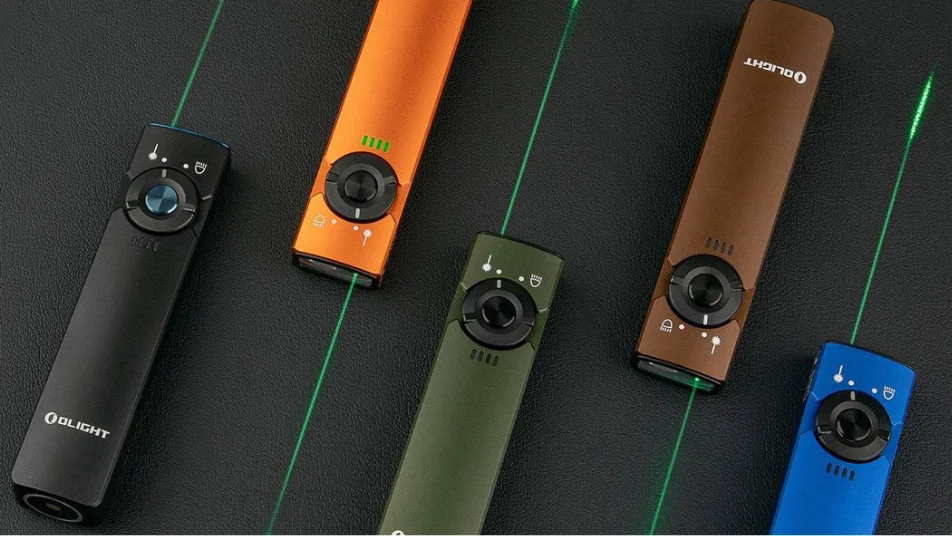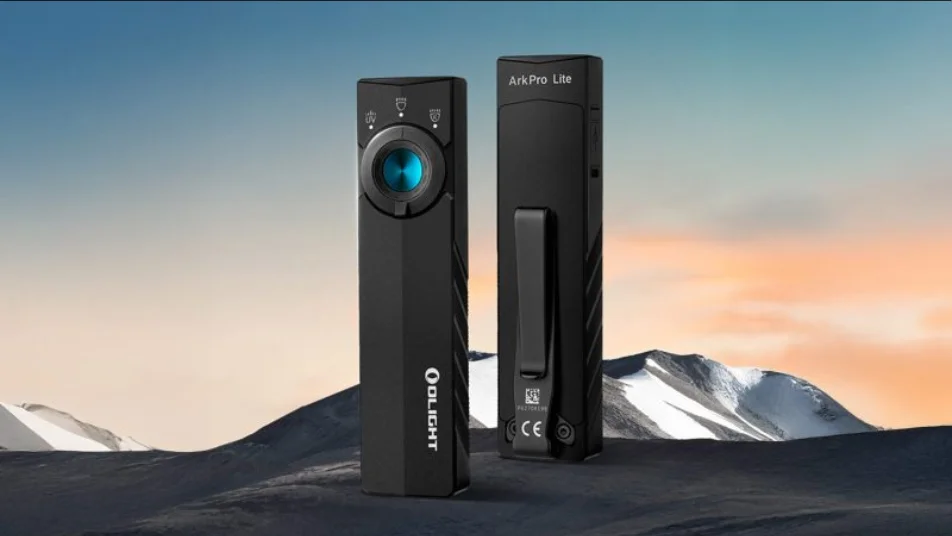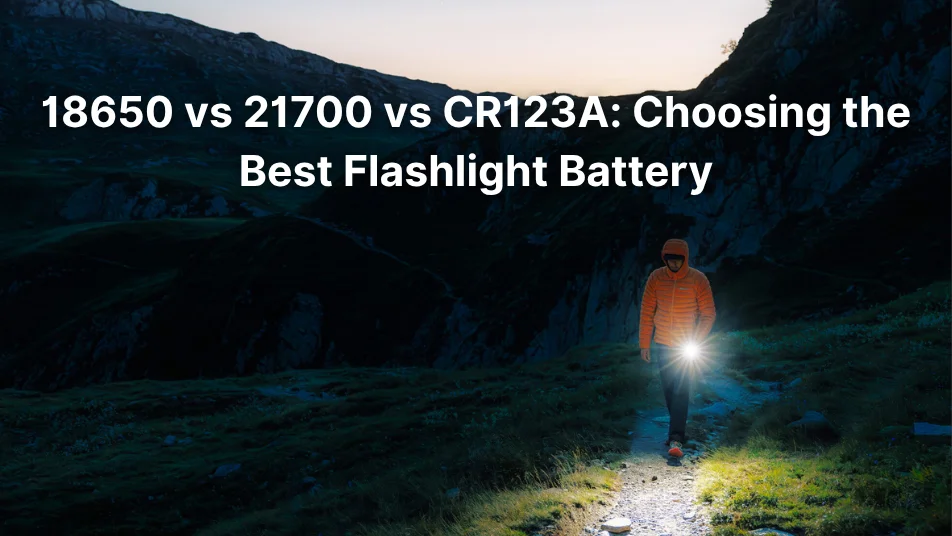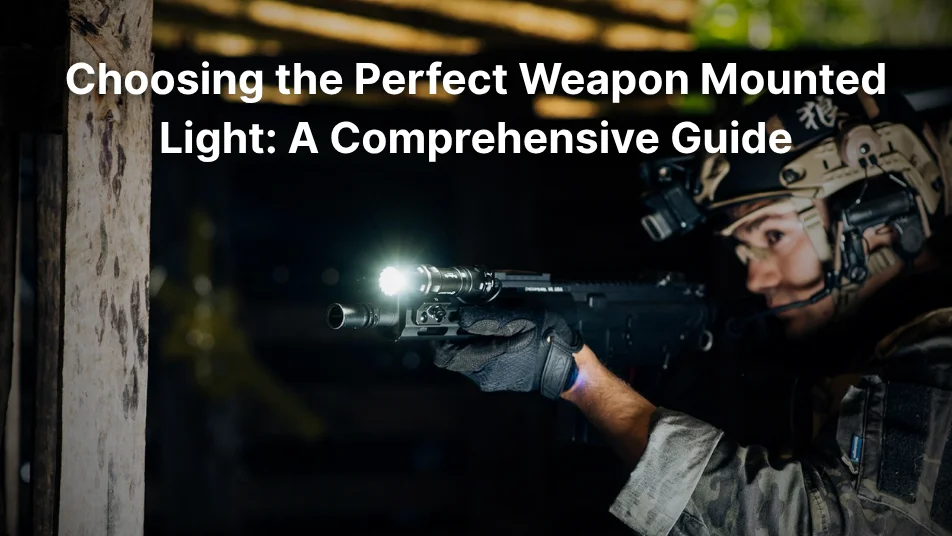Imagine setting out on a low-light or midnight hike in the wilderness, only to find that your flashlight isn’t bright enough or running out of batteries halfway through. A reliable hiking flashlight can make all the difference between a smooth adventure and a frustrating ordeal.
In this guide, we delve into the significance of a good hiking flashlight and explore how to choose the best hiking flashlight for your adventures. We also recommend Olight flashlights for hiking. Let's jump into it!
Why a Good Hiking Flashlight Matters
Illuminate Your Way in Low-Light Conditions
Key Point: Flashlights help hikers navigate safely when daylight fades or when hiking in dark environments such as dense forests or caves.
When hiking during dawn, dusk, foggy, or night conditions, a hiking flashlight provides visibility and helps hikers navigate trails safely. It illuminates the path ahead, making spotting obstacles, trail markers, and potential hazards easier.
According to expert hiker and author Heather Balogh Rochfort, visibility is crucial in preventing accidents. She notes, "A reliable flashlight or headlamp can help you avoid tripping over roots, rocks, or uneven terrain, which is especially important when you’re on unfamiliar trails.”
Safety First and Emergency Situations
Key Point: A high-quality flashlight is crucial for navigation and emergencies. It can provide light in unexpected situations. Such as sudden weather changes, injuries, or delays on the trail.
A flashlight enhances personal safety by illuminating dark areas, deterring wildlife, and making hikers more visible to others. It can also help prevent accidents by highlighting uneven terrain or obstacles on the trail. It helps you avoid tripping hazards, spot potential dangers, and signal for help if needed.
Having a dependable light source can be a lifesaver, especially in an emergency. In a documented case, a group of hikers lost their way after sunset and used their flashlight to signal for help. They were able to stay visible to searchers, and eventually they were rescued. This situation highlights the importance of having a flashlight to improve your chances of being seen and located.
Signaling for Help
Key Point: Flashlights can be used to signal for help in case of an emergency, either by using SOS signals or by catching the attention of rescuers.
In cases of emergencies or getting lost, a flashlight can be used to signal for help by flashing SOS signals or simply shining the light to attract attention. This can be crucial for alerting rescuers or other hikers to your location.
In a scenario described by survival expert Dave Canterbury, a flashlight can be used to create distress signals such as three short flashes, three long flashes, and three short flashes, which is internationally recognized as an SOS signal.
Watch Out for Wildlife
Key Point: Flashlights can help you be aware of wildlife around you, reducing the risk of encounters with potentially dangerous animals.
According to wildlife biologist and hiker Dr. Michael McCormick, “Animals like bears and mountain lions are more likely to avoid humans when they see the light. A flashlight helps in identifying and avoiding wildlife encounters that could escalate into dangerous situations.”
Extended Hiking Hours
Key Point: With a hiking flashlight, hikers can safely extend their hiking hours beyond daylight, allowing for more flexibility in planning and unforeseen delays.
Adventure racer and hiker Jennifer Pharr Davis points out that “carrying a flashlight gives you the flexibility to push your limits and finish your hike even if you’re running late. It’s a game-changer for both day hikes and multi-day treks.”
Checking Gear and Examining Surroundings
Key Point: A flashlight proves invaluable for inspecting your gear, reading maps, and checking equipment, making it essential for examining your surroundings in low-light conditions. It also plays a crucial role in camp setup, cooking, and performing tasks when visibility is limited.
Adventure racer and hiker Jennifer Pharr Davis emphasizes that “a flashlight ensures you’re prepared to handle any situation after dark, from gear checks to navigating tricky terrains. It’s indispensable for a smooth experience in both day hikes and extended treks.”
Flashlight Multi-Functional Use for Hiking
Key Point: A flashlight is useful for checking gear, reading maps, checking equipment, or examining the surroundings. It can also be handy for setting up camp, cooking, or performing tasks in low-light conditions.
Olight hiking flashlights offer powerful brightness for various outdoor activities and emergencies. They not only feature multiple light modes, such as different brightness levels, but also come with additional features such as strobe modes, SOS signals, adjustable brightness levels, and even power banks for charging devices. These versatile functions make flashlights valuable tools for various hiking and outdoor scenarios.
Types of Hiking Flashlights
Handheld Flashlights
Handheld flashlights are versatile and powerful, making them ideal for illuminating large areas or distant objects. They can be heavier and less convenient to carry for long distances, but they often offer superior brightness and durability.
Hiking Headlamps
Headlamps provide hands-free operation, which is a significant advantage for activities like setting up camp or cooking. They’re lightweight, adjustable, and keep the light exactly where you’re looking. For many hikers, a headlamp is the preferred choice for nighttime adventures.
Compact EDC Flashlights (Keychain Flashlight & Pocket Flashlight)
Compact EDC flashlights are lightweight and easy to carry, making them ideal for hiking. They can be attached to a keychain or stashed in a pocket for quick access during emergencies or when additional light is needed.
Multi-functional Flashlights
These flashlights offer additional features, such as SOS signals or lantern functions. They are especially useful for emergency preparedness and versatility, allowing you to adapt your lighting to various situations. Such as tactical flashlights, rechargeable flashlights, and long-battery-life flashlights.
How Do You Choose the Best Hiking Flashlights? (Key Factors)
Brightness (Lumens)
Lumens measure how much light a flashlight emits. More lumens mean better visibility, but they also impact battery life. For general hiking, a flashlight with 100 to 300 lumens is generally sufficient for most trails and activities.
The ideal lumen level for a hiking flashlight depends on different situations and conditions. Here’s a breakdown of what you might need in different scenarios:
General Hiking and Trail Walking
Lumens Needed: 300 to 500 lumens
Why: This range provides sufficient brightness for typical trail navigation and seeing obstacles without being too harsh on the eyes. It also balances battery life and weight.
Low-Light Conditions
If you're hiking at dawn, dusk, or moonlight:
Lumens Needed: 200 to 400 lumens
Why: In low-light conditions, you don’t need as much brightness as in complete darkness. This level will help you see the trail and surroundings clearly while conserving battery life.
Complete Darkness
If you're going hiking at night,
Lumens Needed: 500 to 1,000 lumens
Why: In total darkness, you’ll need more light to illuminate the path and identify potential hazards. Higher lumens will give you a wider and more intense beam, improving visibility.
Close-Range Tasks
If you need to read a map or set up camp while hiking,
Lumens Needed: 100 to 200 lumens
Why: For close-up tasks, you don’t need a very bright light. A lower-lumen flashlight will provide adequate illumination without causing excessive glare or battery drain.
Emergency Situations
If you need to signal for help or navigate through very dense vegetation,
Lumens Needed: 1,000+ lumens
Why: For emergencies or situations requiring maximum visibility, a high-lumen flashlight (1000+ lumens) with strobe or SOS functions can be beneficial.
Keep in mind that higher lumen outputs typically consume more battery power. Consider the battery life of the flashlight based on your hiking duration and whether you can recharge or replace batteries easily during the hike.
Battery Life
Flashlights come with various battery options, including rechargeable and disposable. Rechargeable batteries offer convenience and are often more cost-effective over time. Disposable batteries are handy for long trips where charging might not be feasible. Consider your hiking duration and the availability of power sources when choosing.
Beam Distance
The ability to adjust the beam distance and focus is important for different hiking scenarios. A longer beam distance helps you see far ahead, while adjustable focus allows you to switch between a broad floodlight and a focused spotlight, catering to both close-up tasks and long-distance visibility.
Durability
A flashlight should withstand drops and resist water to handle various outdoor conditions. Look for rugged construction and IPX ratings that indicate how water-resistant the flashlight is. A flashlight made from durable materials will last longer and perform better in harsh environments.
Size and Weight
When hiking, every ounce counts. Compact, lightweight flashlights are easier to carry and won’t weigh down your pack. However, they should still be sturdy enough to handle rough use.
Top Picks: The 5 Best Hiking Flashlights of 2024
Hiking Flashlight 1: Seeker 4 Pro (Handheld Flashlights)
Key Features:
High Brightness: Max 4600 lumens of brightness, with 260 meters of beam distance.
6 Multiple Modes: Turbo, High, Medium, Low, Moonlight, and Strobe Mode.
Rechargeable Battery: Equipped with a 5000mAh 21700 rechargeable lithium-ion battery, with two charging options: USB and magnetic charging.
Safety Features: The holster features quick lock and unlock, balancing safety and convenience. Integrated thermal protection to prevent overheating and over-discharge protection to extend battery life.
Durability: IPX8 Waterproof. Made from aircraft-grade aluminum with an anodized finish, it has an impact resistance of up to 1.5 meters.
Usage Scenarios:
Outdoor Adventures: Ideal for camping, hiking, night duty, and dog walking night-time outdoor activities where high visibility is essential.
Emergency Situations: Useful as an emergency flashlight for power outages or search and rescue operations.
Price: $139.99
Hiking Flashlight 2: Warrior X 4 (Handheld Flashlights and Tactical Flashlights)
Key Features:
High Brightness: Offers up to 2600 lumens of output with a 630-meter beam distance.
4 Multiple Modes: Low, High, Tactical, Regular, and Strobe Mode.
Magnetic Tail Cap: Includes a magnetic tail cap for hands-free operation, allowing the flashlight to be attached to metal surfaces.
Rechargeable Battery: Powered by a 5000mAh 21700 lithium-ion rechargeable battery, it has two charging options with both USB-C and MCC3 recharging. Also, there is a three-color battery level indicator to monitor the remaining charge easily.
Durability: It is built to withstand impacts up to 1 meter and is waterproof with an IPX8 rating, making it suitable for harsh conditions.
Tactical Tail Switch: Provides easy access to the flashlight’s various modes and features, including a momentary-on function.
Usage Scenarios:
Tactical Use: Ideal for law enforcement, military, and security personnel requiring a powerful and reliable flashlight in tactical situations.
Outdoor Activities: Suitable for camping, hiking, and other outdoor adventures where a high-performance light source is needed.
Emergency Situations: Useful as a dependable light source during emergencies, such as power outages or search and rescue operations.
Price: $129.99
Hiking Flashlight 3: Perun 2 Mini LED (Rechargeable Headlamps)
Key Features:
Brightness: Provides up to 1,100 lumens of output with a beam distance of up to 150 meters.
Rechargeable Battery: Customized 650mAh 3.6V IMR16340 Rechargeable Lithium Battery, Magnetic Charging.
6 Multiple Modes: 5 white light modes and SOS emergency signaling mode.
Adjustable Headband: Provides 180° rotation for multi-angle lighting. It can be used as a headlamp or a handheld flashlight with a detachable headband.
Durable Construction: Made from aircraft-grade aluminum, with an IPX8 waterproof rating and impact resistance up to 1.5 meters.
Usage Scenarios:
Outdoor Activities: Ideal for camping, hiking, and nighttime outdoor activities where hands-free lighting is required.
Emergency Situations: Useful in power outages, search and rescue operations, and other emergency scenarios.
Price: $64.99
Hiking Flashlight 4: Baton 3 Pro Max (Compact EDC Flashlights)
Key Features:
Brightness: Up to 2500 lumens with a 145-meter beam distance.
Battery Life: Long-lasting rechargeable battery with USB-C or magnetic charging.
6 Multiple Modes: 5 White Light Modes and a Strobe.
Waterproof and Impact-Resistant: IPX8 rating, designed to withstand drops.
Multifunctional Magnetic Tail: MCC3 USB magnetic charging also allows for hands-free operation with a magnetic tail.
Usage Scenarios:
Outdoor Adventures: Perfect for camping, hiking, and night-time activities.
Emergency Preparedness: Reliable for power outages and emergency situations.
Price: $89.99
Hiking Flashlight 5: Javelot (Long Range and Battery Life Flashlights)
Key Features:
Brightness: Delivers up to 1350 lumens or more, with a 730-meter beam distance and long-range illumination.
Battery Life: The 5000mAh 21700 battery provides 72 days of runtime. Equipped MCC3 USB Magnetic Charging Cable.
6 Lighting Modes: Turbo, High, Medium, Low, Moon, and Strobe Mode.
Optional Remote Switch (sROD-7): Get a reliable push-to-lock magnetic remote switch to turn it into a powerful WML.

Usage Scenarios:
Search and Rescue: Ideal for search and rescue operations due to its long-range capabilities.
Outdoor Adventures: Perfect for hiking, camping, and other outdoor activities requiring powerful illumination.
Price: $104.99
How to Maintain and Care for Your Hiking Flashlight
Cleaning and Storage
Regular Cleaning:
Exterior Cleaning: Wipe the exterior of the flashlight with a soft, damp cloth to remove dirt, mud, and grime. Avoid using harsh chemicals or abrasive materials that might damage the finish.
Lens Care: Clean the lens with a lens cleaner or a microfiber cloth. If the lens is particularly dirty, use a lens brush to remove loose debris before wiping it clean. Be cautious not to scratch the lens.
Internal Maintenance:
Avoid Water Damage: Even if your flashlight is water-resistant, it’s a good practice to dry it thoroughly if it gets wet. After exposure to saltwater or muddy conditions, rinse it with fresh water and dry it completely to prevent corrosion.
Storage Tips:
Dry Environment: Store your flashlight in a cool, dry place away from direct sunlight. Excessive heat, cold, or humidity can affect its performance and longevity.
Battery Removal: If you won’t be using your flashlight for an extended period, remove the batteries to prevent potential leakage and corrosion. Store batteries separately in a dry, cool place.
Protective Case: Consider using a protective case or pouch to shield the flashlight from physical damage and environmental factors during storage or transport.
Battery Care for Hiking Flashlights
Rechargeable Batteries:
Charging Practices: Always use the charger specified by the manufacturer for your flashlight’s batteries. Overcharging can reduce battery lifespan, so unplug the charger once the battery is fully charged.
Storage: During non-use, store rechargeable batteries in a cool, dry place and avoid leaving them in extreme temperatures. If the battery is not going to be used for a long time, charge it to about 50% and then store it. This practice helps prevent the battery from falling into a deep discharge state, which can be harmful.
Disposable Batteries:
Replacement: Replace disposable batteries as soon as they are depleted to ensure your flashlight remains functional. Avoid mixing old and new batteries, as this can lead to uneven power distribution and potential leakage.
Proper Disposal: Dispose of used batteries properly by following local regulations for battery recycling or disposal. Many outdoor gear stores and recycling centers offer battery disposal services.
Temperature Considerations:
Be mindful of temperature extremes, as both very hot and very cold conditions can affect battery performance and lifespan. When hiking in extreme conditions, keep spare batteries in an inner pocket to maintain their temperature and performance.
Tips for Using Your Hiking Flashlight
Proper Usage:
Adjust the flashlight’s brightness to suit your environment and needs, which helps conserve battery life and reduces eye strain.
Use the flashlight responsibly by avoiding shining it directly into other people's eyes to prevent temporary blindness.
Take advantage of features like dimming or red light modes to preserve your night vision and avoid disturbing wildlife.
Emergency Preparedness:
Keep your flashlight in your emergency kit and make sure it’s easily accessible for sudden darkness or unexpected situations.
Carry spare batteries or a backup power source and be familiar with how to replace them quickly to avoid running out of light.
Test your flashlight regularly to ensure it's working properly before you head out on a hike.
Regular Maintenance:
Clean the lens and battery contacts often to prevent dirt or corrosion from affecting performance.
Check the flashlight for any signs of damage, such as cracks or loose parts, and repair or replace it as needed.
Store the flashlight in a dry, cool place to protect it from moisture and extreme temperatures that could damage its components.
Battery Management:
Use high-quality batteries for better performance and longer life, especially in cold weather.
Replace batteries before they’re completely depleted to avoid losing power during your hike.
Consider bringing a compact battery charger or extra sets of batteries for longer trips or emergencies.
Wrapping Up
A hiking flashlight is a versatile and indispensable tool for hikers. Key concerns include lumen brightness, beam distance visibility, battery life, size and weight, durability, and emergency signaling. These factors keep you at peace during outdoor adventures. Whether you’re a seasoned hiker or a weekend adventurer, Olight hiking flashlights will enhance your safety and enjoyment. Have an enjoyable and safe hiking trip! Please share your experiences with hiking flashlights in the comments.

